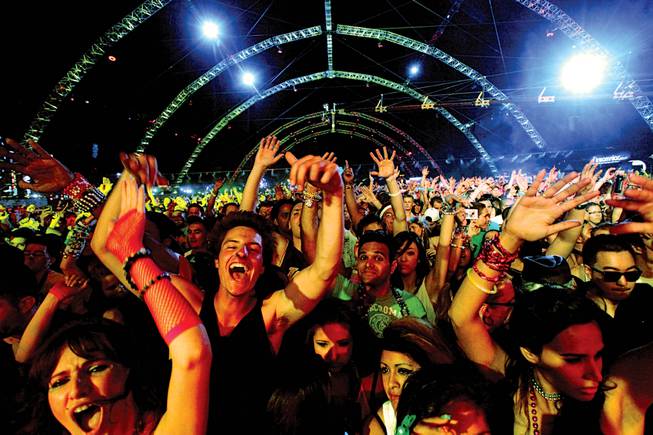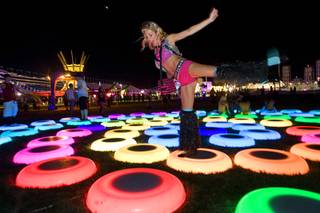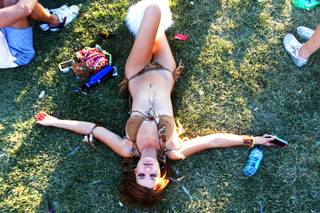Wednesday, June 29, 2011 | 5:31 p.m.
It’s clear that Electric Daisy Carnival’s organizers, following chaos and controversy in LA, want respect. They want the event to be considered in the same breath as Coachella or Bonnaroo, the latter another death-plagued festival with less of the kind of critical press coverage received by the rave that came to Las Vegas Speedway for three days last weekend.
Here’s a professionally produced event with top musical talent and 14 years of tradition that is separated from other concerts mainly by its content: electronic dance music. Its 2010 LA edition was marred by more than 200 medical emergencies, 60 mostly drug-related arrests, and the death of a 15-year-old girl who had taken ecstasy.
Then, earlier this month, three deaths (including one from 2010) were tied to the event’s Dallas edition. Organizers have hired PR specialists and lobbyists to fight a publicity war. EDC, they say, is not a rave; it’s a successful music fest held in four American cities and Puerto Rico. And, by the looks of it, organizers want back into LA, where authorities have turned a cold shoulder to the party following last year’s controversy and the revelation that promoters reportedly paid a public employee at the LA Coliseum more than $800,000.
EDC has a five-year contract at the Speedway and, if you ask us, it turned out to be an ideal location—vast, clear, warm, well-organized and with plenty of parking. Rumors indicate EDC honcho Pasquale Rotella wants to supplement next year’s party with a week’s worth of events that would challenge Miami’s Winter Music Conference and Ultra Music Week in March as a global retreat for DJ culture. We wouldn’t blame him. The Strip was alive with beat-driven pool parties and superstar DJs.
Indeed, EDC’s promoters claimed a clear victory in Vegas—nobody died and arrests (60 total) and medical emergencies (300-plus) were comparable to LA’s. They say 230,000 people showed up over three days. (Conservative estimates put it closer to 215,000—72,000 on Friday, 80,000 on Saturday and 63,000 on Sunday).
But a festival is more than the sum of its crime stats and ticket sales. It’s about vibe, once-in-a-lifetime experiences and breadth of talent.
Certainly EDC had its magical moments, from the 2 a.m. fireworks that seemed to aim their middle finger at LA, where it would have been closing time, to Empire of the Sun’s neon-Gothic glory; from Roger Sanchez’s New York City tribal stomp to Sean Tyas & Simon Patterson’s unrelenting trance assault; from Richie Hawtin’s prescient techno futurism to Donald Glaude’s hand-raising disco riot. Even the likes of Paris Hilton and Flavor Flav made appearances.
And we won’t forget seeing a twinkle-lit Bunny of Rabbit in the Moon speeding through the Speedway infield behind the wheel of a golf cart loaded with lovelies grooving to the echoing kick drums.
Chicago house legend Green Velvet appeared at EDC like a lifetime achievement award winner, a survivor of the kind of swirling, thumping, disco-cut-up sounds that gave rise to the likes of Daft Punk. And it seemed that all the A-listers (Tiësto, David Guetta, Steve Angello) played modern interpretations of Green Velvet’s ravey ode to nitrous oxide, “Flash.” Along with re-rubs of Adele’s “Rolling in the Deep” it was one of the tracks of the weekend.
Not that a party like EDC should turn into a snooze-worthy geezer fest like the Grammy Awards—Green Velvet has seen a worthy resurgence in bookings in Europe—but it’s nice to see roots on display at an event where most of the fans were just babies when Chicago was experiencing its second wave of house.
There were plenty of feathers in EDC’s cap in the lineup (Paul Oakenfold, Ferry Corsten, Hawtin), and seeing the likes of Tiësto, Swedish House Mafia and Guetta working a main stage sound system that could have blown Pahrump off the map, it would be hard to argue the promoter ever cheaped out on talent or production. The loudspeakers created their own weather; the walls of light blasted your eyes with techno-color; and performers pretty much appeared like clockwork, on schedule.
Even if you have a problem with the mainstream appeal of Benny Benassi or Calvin Harris, the scope of EDC’s production and the size of the masses amplified the electronic dance music to stadium-rock status. There was an inherent glory to almost everything on the big stages. It was almost like seeing a kid you knew from Little League playing the final game of the World Series. EDC was a heart-pounding experience.
That’s why it would have been nice to see more chances taken. Green Velvet on the Kinetic Field main stage, instead of at the Circuit Grounds. How about house music titan Donald Glaude, who has never, ever failed to rock the shit out of a party, on a larger platform? In fact, the biggest party rockers in America (Glaude, DJ Dan) were relegated to a little double igloo called the Heineken Domes. That was a shame. At least there was a sizable line to get in when they were on.
EDC
- Electric Daisy Carnival
- Click here for the Weekly's extensive coverage of the EDC 2011.
Surprises at Las Vegas Motor Speedway were rare, and if you were versed at all in the talent of clubland, you’d be hard-pressed to find previously unknown DJs or musical flavors you hadn’t yet heard.
EDC, in fact, was a one-stop survey of what’s happening now on the dancefloor, from the radio-friendly house-pop of Guetta to the clubland ascension of Australia’s Dirty South. Guetta even pulled the call-and-response trick, pulling down his mixer’s fader so people could sing the words to his radio hit “Where Them Girls At?”. Hearing a No. 1 single like “Rolling in the Deep” get played so many times made us wonder if we were part of a once-underground phenomenon or a Billboard convention.
Of the five stages, perhaps only the Bass Pod—a vestige of drum ’n’ bass’ past and a showcase of its shoe-gazing offspring, dubstep—felt the least bit challenging in its rumbling, low frequencies and ragga-inflected MCs. But the roots of that music are now more than 15 years old. And nobody from England is ever going to teach Americans about breakbeats or rap.
The most promising outgrowth of electronic dance music in the last five years, the kind of nu electro represented by the likes of Steve Aoki and A-Trak, evolved into just another four-on-the-floor genre of epic breakdowns and huge buildups at EDC. Nothing they played—squelchy house with stabs of 303 acid—was much different from what you heard on the other big stages. The punk-rock aesthetic of the neon-clad new kids has turned out to be just another excuse to drink beer and woot-woot to thumping beats.
It’s not EDC’s fault that onetime main-stagers like Aoki, who once expressed his disdain for continuous house-style DJ sets while touting cut-and-paste indie-rock influences, have turned out to be side-stage frauds. But it is EDC’s fault for giving them so much real estate.
Rather than pushing the boundaries of what’s possible in dance music, EDC simply amplified the obvious and touched all the demographic bases for maximum ticket sales. You want radio dance? You got it. Techno? Sure, Richie Hawtin is here. New York clubland sounds? Go see Roger Sanchez. You’re a cool kid in American Apparel? The Neon Garden is for you. Yes, EDC had the live (Empire of the Sun) and the left-field (Röyksopp), but they seemed few and far between.
In LA the debate over EDC and whether to allow it to continue to be held on public land at the LA Coliseum often centered around the meaning of the word “rave.” City Councilman Bernard Parks said a rave is, by definition, an illegal, underground party: An event like EDC, with its huge production, mega-stars and cops galore could never be considered a rave.
We’d argue that the likes of EDC have changed the definition. An audio-visual Disneyland of thumping EDM attended by 80,000 ravers—that’s a rave. To wit, no one calls small, illicit events raves anyway. Those are just warehouse parties.
A rave is a “massive,” a legit DJ concert with largess and cosmic playgrounds, gardens and amusement park rides that recall a sense of psychedelia (it’s called Electric Daisy Carnival for a reason). That’s what the kandi kids will tell you. A rave is now, by definition, a mainstream celebration. Nobody who organizes the kind of illegal party described by LA’s former police chief, Parks, intends to do anything like a rave. They’ll leave that to the millionaires.
EDC should own it. There’s nothing wrong with a rave like EDC on paper. It’s when the bullshit starts flying—it’s not a rave; nobody does ecstasy; well, some people do ecstasy, but it’s mostly alcohol that’s the problem—that EDC becomes hard to swallow.
Pair that with the fact that EDC has done everything in its power to make the event an ecstasy user’s wet dream—continuous, bass-driven grooves, visual candy, chill-out rooms, glow sticks and Ferris wheels—and it’s easy to see why we’re not convinced this has transcended rave culture.
Forget the debate about raves and ecstasy for a second, though. The criticism here is about the music and experience: If anything, EDC could use some of the underground electricity of illicit parties’ past. Ironically, that’s what’s missing here. Edge. Adventure. Rebellious attitudes.
Cash in-hand from its largest edition yet, EDC’s organizers need to think outside the DJ booth and, like a good sommelier, consider both pop and avant-garde pairings that would expand the impact of this powerful gathering. Might some of the rappers (Flo Rida?) and pop stars (Lady Gaga?) who have capitalized on dance music’s popularity show up? (Will.i.am was booked as a DJ at EDC last year.) Is there more to the main stage than big-chord house?
Sure, it protected (nobody died) and served (talent was huge), but EDC missed an opportunity to educate by mixing more interesting clubland names—albeit ones further down the marquee—in with the prime-time, big-stage A-listers. Heck, Coachella put Air on the big stage at sunset. Even if you weren’t a fan you stayed, and you fell in love.
Groove Armada? Basement Jaxx? Daft Punk? Massive Attack? If EDC is the premier electronic dance music festival, why does Coachella book more of the scene’s most critically acclaimed stars?
If it’s not a rave, as EDC’s organizers contend, go ahead, put your elbow in Coachella’s face and stake a claim for all forms of electronic. You have the cred and the momentum: Make something of this other than a kandi kid’s beat fest. Book LA disco legend DJ Harvey. See if Girl Talk will demonstrate his jaw-dropping mash-ups. Get Bryan Ferry to come by and sing atop DJ Hell’s beats. We want Sean “Diddy” Combs to rap as Felix da Housecat spins. Put Louie Vega’s salsa big band Elements of Life onstage. You want respect? Do this.
Here’s the heart of the matter: While the festival wants to be taken seriously as a critical showcase of so-called EDM, it seems loathe to book anything other than wall-to-wall house, trance and techno beats—a la raves of yore. Wouldn’t want the kids to have to pause, think and enjoy, especially if they’re cranked up like the Energizer Bunny. To stand around while a band sets up would be antithetical to the beats-nonstop ethos of rave culture.
In the end, EDC’s three nights in Vegas were thoroughly entertaining and electrifying—the place to be for DJ culture in June. But a critical star in the vast landscape of global pop festivals? Not yet guilty.
This year’s edition felt more like a snapshot of the popular rather than a challenge to ravers to think outside the pillbox. Maybe next year.
LA Weekly’s Dennis Romero—a veteran dance music writer who reported on EDC LA 2010 and its aftermath—covered EDC Las Vegas exclusively for Las Vegas Weekly.





Join the Discussion:
Check this out for a full explanation of our conversion to the LiveFyre commenting system and instructions on how to sign up for an account.
Full comments policy